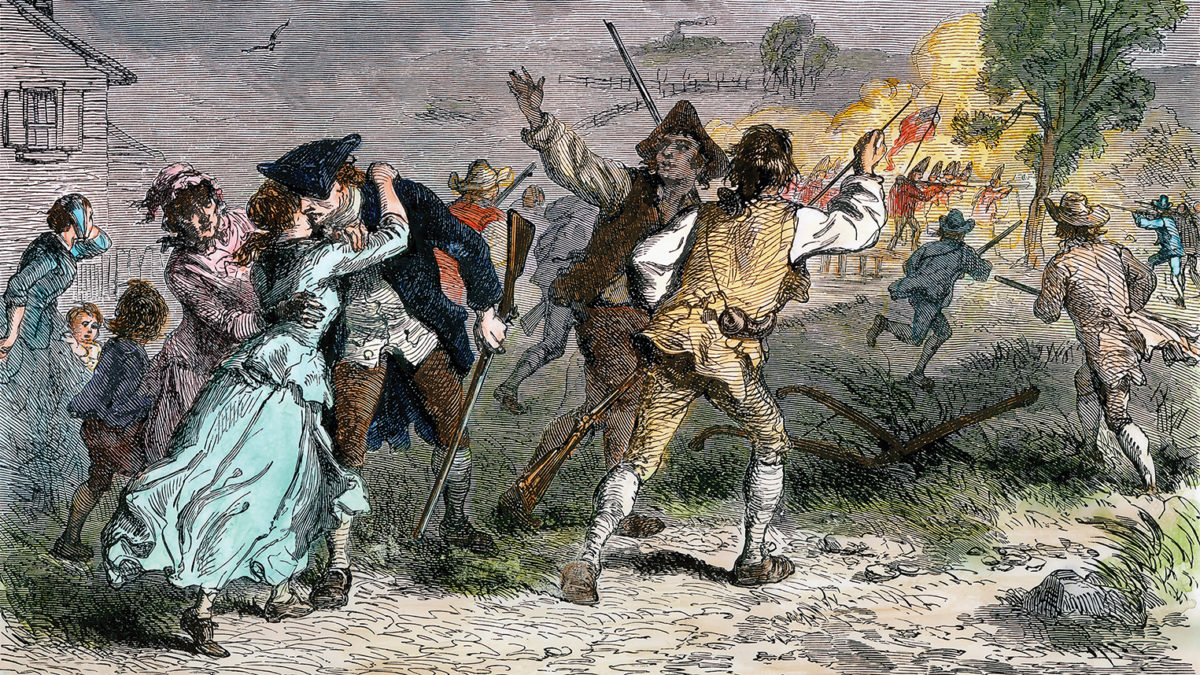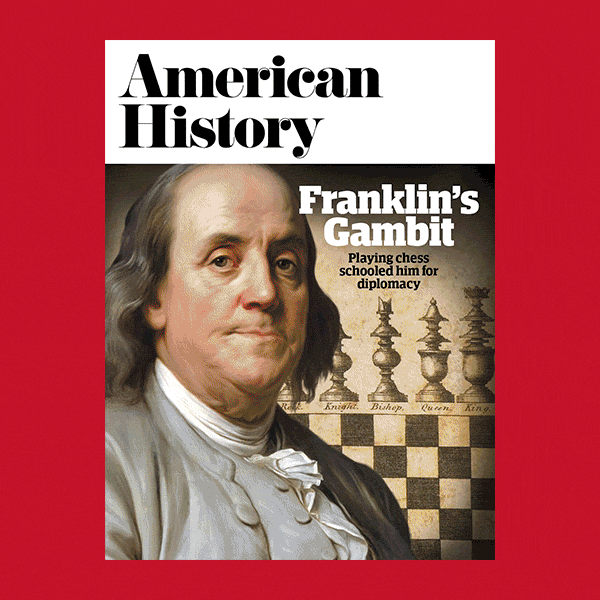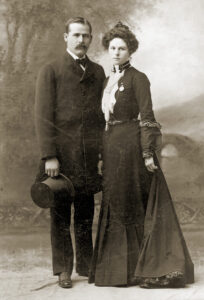In the wee hours of April 19, 1775, long before dawn’s first glimmer, Jonathan Harrington of Lexington, Massachusetts, woke suddenly at his mother’s insistence. “Jonathan, Jonathan,” Abigail Harrington cried, rousting her 16-year-old. “The reg’lars are coming and something must be done!”
“I dressed quickly, slung my light gun over my shoulder, took my fife from a chair, and hurried to the parade near the meeting house, where about 50 men had gathered,” the grown Jonathan said years later. “Others were arriving every minute.”
Decades on, famous as the last survivor of the American Revolution’s opening battle, Jonathan Harrington often heard requests to recount the day’s events. What he recalled was his impassioned mother, urging her husband and first-born son to battle. To his dying day Harrington praised his mother as “one of the most patriotic women who ever lived.”
The resolution and bravery the Lexington militia showed on the town green that morning against veteran units of the world’s most powerful army are well enshrined. But Jonathan Harrington had in mind something more: the role of Lexington’s women. Long before sending their men into combat that April 19, the town’s wives and sisters and mothers had been protesting actively against Crown infringements on colonial rights.
By 18th-century norms, proper female behavior excluded political engagement. Society considered it unnatural for a woman to speak or to act in public; rather, she was to sequester herself in the domestic sphere. Yet women in Lexington embraced and acted on the revolutionary rhetoric of liberty—for much of that rhetoric was aimed directly at them. For 10 years before war broke out, Lexington’s women had been hearing exhortations to apply their domestic skills to political protest and resistance. In the name of tradition, they were being urged to rebel. And they answered that call in the affirmative.
Their main inciter was the town’s popular and influential Whig minister. Jonas Clarke shared the providential Puritan view that everything in life had a divine cause and meaning. As political unrest was mushrooming in the 1760s, Clarke preached of what he saw as discontent’s root cause: congregants’ greed and acquisitiveness, which base characteristics he saw bringing on the yoke of imperial slavery, as in biblical times. To redeem themselves and their political liberty, Clarke said, the faithful had to act to preserve their sacred and civic welfare. In this endeavor, as “Handmaids of the Lord,” women had a direct role, Clarke declared.
Clarke preached against excessive fondness for worldly goods—the getting and flaunting of imported attire and furnishings. This was woman’s realm. In his sermon “The Best Art of Dress,” the cleric inveighed against a rising fad for finery—“the great degeneracy of the present times,” he called it. “People are much for the fashion, and young people for those ornaments which they think are beautiful and excellent,” Clarke railed. “And they are apt to set much by them, and value themselves highly upon them, when obtain’d.” Clarke chivvied townsfolk to abandon “vanities and temptations” and to eschew “fashionable dress” for the “white robes of righteousness.” By substituting home-made goods for imported finery women could demonstrate piety—and become potent political actors.
By the mid-1760s, women’s domestic economy stood at the center of a political maelstrom. As Britain was trying to finance the French and Indian War by taxing imports to the colonies, American Whigs smelled a rat: an unconstitutional effort to refill the empire’s depleted coffers by impoverishing colonials. Many Whigs suspected a parliamentary conspiracy to tax the colonies into debt peonage. Lexington residents were articulating this fear as early as 1765 in response to the Stamp Act. In town meeting they complained of the act as “… a yoke too heavy for us to bear…. [I]t will quickly drain the Country of the little cash remaining in it, strip multitudes of their property, and reduce them to poverty in a short time … [O]f natural and freeborn subjects we shall become the most abject slaves.”
Clarke had reason to fear overspending and debt to British creditors. As Lexington matured into its third settled generation, townsfolk were buying more and producing less. Between 1740 and 1770, the value of luxury goods purchased in Lexington rose by a factor of 10. In the 1750s, Dr. Robert Fiske’s wife, Betty, had set her table with pewter, earthenware, and old knives and forks; a generation later, her son’s wife, Hepzibah, could boast of owning china, silver spoons, brass candlesticks, a coffee pot, and tinware. Similar creature comforts graced neighboring households.
When Lydia Mulliken’s husband, Nathaniel, died in 1768, his estate included a “bewfat”—also known as a buffet or sideboard—for displaying fine china; a portrait; a desk; cases of drawers; mirrors; a tea table; items of pewter and brass; and glassware. These all signified genteel taste. But they came from abroad, bought with cash.
Whig fears arose from economic reality: by mid-century, more Lexington farmers had gone in debt, and more were losing farms to creditors. Rising indebtedness reflected a demographic crisis of limits: after multiple generations of sons settling nearby, Lexington fathers were running out of land to hand down. By mid-century, many had borrowed to finance their sons’ settlement elsewhere. New taxes further stoked anxiety.
People complained that greedy rulers were making off with the fruits of the people’s labor; that such policies would impoverish them; that poverty would beget foreclosures, in which corrupt and tyrannical British lords seized their land. As Britain had done to the Irish, colonials would be returned to feudalism, with great lords taking over the countryside and independent farmers reduced to tenancy or serfdom.
To Clarke and other Whigs, there was a clear mandate: households must consume less and produce more. This was women’s work. Gathering the necessities of “going to housekeeping” and supplementing those basics with domestic comforts were the tasks of a young woman before marriage, and her business after. It was to women, then, that Rev. Clarke was addressing his ominous warning: consumption constituted a vanity that would lead—in both biblical and Whiggish rhetoric—to enslavement, figurative and literal.
In 1767, the year that Parliament passed the Townshend Duties, taxing a much wider array of goods, a cry went up to boycott taxed imports and fill the resulting household gaps with homemade goods. “If this savings is not made, Interest must rise,” Boston almanac writer Nathaniel Ames warned. “Mortgages cannot be cleared, Land will fall, or be possessed by Foreigners…” Were households to replace imports with homemade goods, “a whole Province will be saved from Slavery.” Women’s domestic economy would determine which eventuality was to be.
In 1768, Lexington town meeting adopted measures “to promote frugality and economy”—a campaign dictated by men but implemented by women. Letters in the Boston Gazette appealed directly to women. “Ladies, . . .I am convinced that at this present it is. . .in your Power, to effect more in favour of your Country, than an Army of an Hundred Thousand Men …” a correspondent importuned.
In 1768-69, politically minded women organized public “spinning bees.” In large groups, working outside sunrise to sunset, they spun yarn to show patriotism. To be seen in public in the act of spinning became a political act much celebrated in the press. One Boston 1769 broadside honored the women warriors at the wheel:
Boston, behold the pretty Spinners here,
And see how gay the pretty Sparks appear:
See Rich and Poor all turn the Spinning Wheel,
All who Compassion for their Country feel,
All who do love to see Industry live,
And see Frugality in Boston thrive.
The women of Lexington were not to be outdone. In previous decades, they generally had ceased spinning and weaving yarn in favor of imported fabric; now they needed to revive the ancient craft. Lexington’s wheelwright, militia captain John Parker, filled orders for 10 times the usual number of spinning wheels during the boycott years. On August 31, 1769, according to the Boston Gazette, Lexington hosted a “spinning party.”
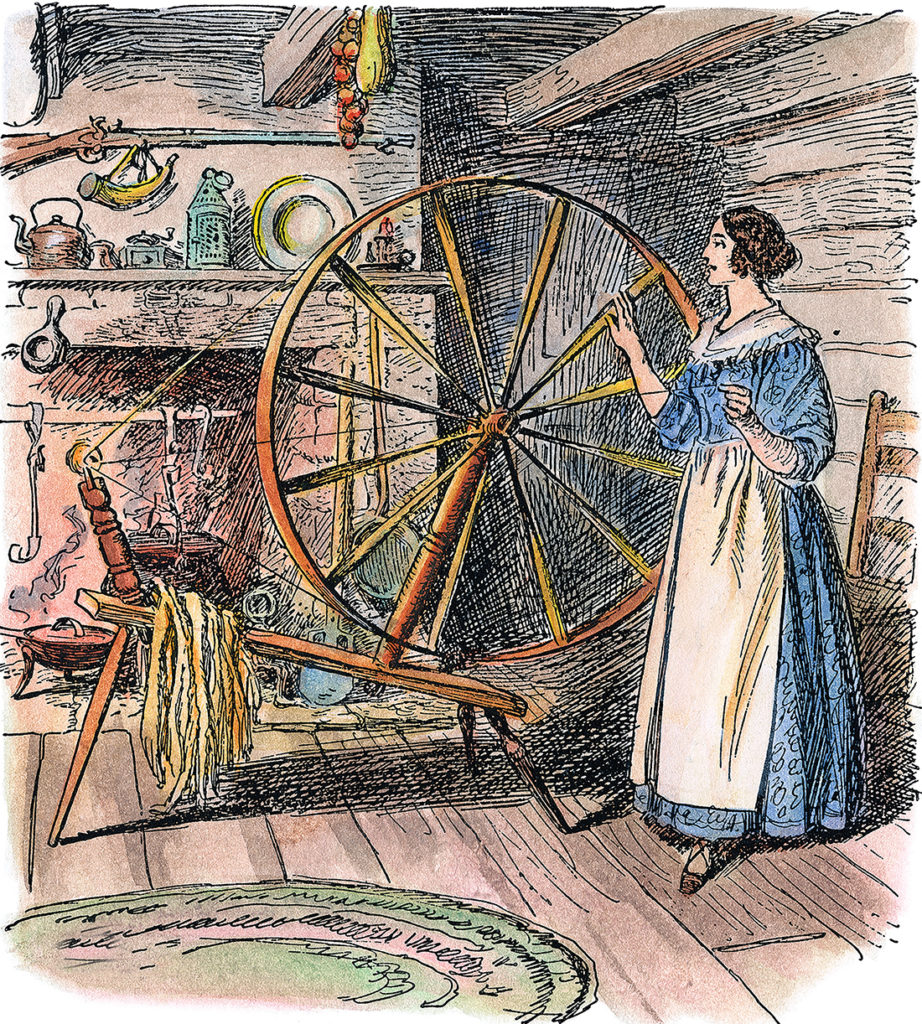
Very early in the morning, the young Ladies of this town, to the number of 45, assembled at the house of Mr. Daniel Harrington, with their Spinning Wheels, where they spent the day in the most pleasing satisfaction: and at night presented Mrs. Harrington with the spinning of 602 knots of linen and 346 knots of cotton. If any should be inclin’d to treat such assemblies or the publication of them in a contemptuous sneer as thinking them quite ludicrous, such persons would do well first to consider what would become of one of our (so much boasted) manufactures, on which we pretend the welfare our country is so much depending, if those of the fair sex should refuse to “lay their hands to the spindle” or be unwilling to “hold the distaff.” Prov. 31:19.
Agitation over boycotted goods and “home manufactures” cooled in the early 1770s. Then Parliament brewed a fresh pot of tempest with the 1773 Tea Act, a piece of legislation that was intended to promote sale of imported tea at bargain prices—and to tax those purchases. Boston’s Whig leaders feared this ploy would beget a monopoly on trade and a new form of unconsented taxation. Calls arose for a tea boycott.
For women, this was a Biblically hard teaching. Tea drinking, with its rituals and equipage, anchored notions of female respectability and refinement. In Lexington homes, among the most common luxuries was the tea service, with its china cups and saucers, silver pots, and trappings of presentation and service. One Lexington historian noted that in local memory, “the greatest luxury of women was their tea, their greatest dissipation to make calls in the afternoon and have a dish of tea and to gossip over it.” Newspapers printed a lady’s lament at putting aside this ritual:
“Farewell the Tea-board with your gaudy attire,
Ye cups and ye saucers that I did admire;
To my cream pot and tongs I now bid adieu,
That pleasure’s all fled that I once found in you. . .
No more shall my teapot so generous be
In filling the cups with this pernicious tea,
For I’ll fill it with water and drink out the same,
Before I’ll lose LIBERTY that dearest name. . .”
In late November 1773 ships arrived in Boston harbor bearing the contested tea. Lexington citizens gathered immediately in town meeting and voted to oppose “the landing, receiving, buying or selling, or even Using any of the Teas.” Moreover, they unanimously declared, they would treat “with Neglect and Contempt” and would look upon “as an Enemy to this Town and to this Country” any person who did purchase or consume any tea. Gathering their household stocks of tea, townspeople paraded to the common and committed all to a giant bonfire. Men may have resolved to destroy the tea; however, that staple was under their wives’ control, part of the stores to which mistresses held the key. Lexington’s women had to consent to the seizure and immolation of their tea. And they did.
Whig papers lauded Lexington’s united front. A letter to the Massachusetts Spy declared, “The patriotic conduct of the town of Lexington is a matter truly worthy the notice and imitation of every town in the province, whose members are well-wishers to the cause of liberty.”
Three days after Lexington townsfolk publicly burned their tea, a group of men in Boston destroyed the noxious import in what is remembered as the “Boston Tea Party.” Parliament was not amused. In spring 1774, London retaliated by imposing the punitive Intolerable Acts: closing the Port of Boston, quartering British soldiers in private homes, stripping Massachusetts of self-government, and banning town meetings.
Afire with resistance, many municipalities signed covenants pledging a complete boycott of imported British goods—and woe betide those who did not comply. Reverend Clarke’s diary reported that his town met and pledged not to purchase English goods. It is not known if Lexington women signed this covenant, though women elsewhere famously did, to ridicule by British cartoonists who caricatured ladies’ participation in politics. But Clarke found the matter deeply serious. He preached that the colonies’ “troubles” were partly the fault of their inhabitants’ worldly and covetous behavior. “When a generation forsak[es] the Lord God of their fathers and serve[s] other Gods, alas. . .they are delivered. . .under the hands of the Spoilers to be spoiled. Yea, . . .from being a free and independent People, [they] are brought under the yoke of oppression. . .”
With matters aboil in autumn 1774, town representatives met in an extra-legal convention held at Concord and adopted radical and treasonous measures. The convention advised each town to raise money, men, arms, and ammunition for defense. Lexington complied.
Residents reorganized their militia, which started drilling regularly to “ensure military Discipline, and to put themselves in a position of defense against their enemies.” Enlarging the town’s stocks of gunpowder, balls, and flint and purchasing bayonets for training soldiers, along with a pair of drums “for the Use of the Military,” Lexingtonians voted to bring two cannon from Watertown “and mount them at the Town charge.”
The men did not act alone. Women’s hand in stoking the fires of martial resistance was noted by a Loyalist: “The Americans would certainly have abandoned the cause long ago and bowed to the yoke, but that a certain epidemical kind of phrenzy runs through our fair country women, which outdoes all the pretended patriotic virtue of the more robustic males. These little mischief making devils have entered into an almost unanimous association that any man who shall basely and cowardly give up the public cause of freedom, shall from that moment be discarded [from] their assemblies, and no future contrition shall be able to atone for the crime. This has had a wonderful effect, and not a little served to increase the provincial forces.”
When the alarm bell rang shortly after 1 a.m. on April 19, 1775, the women of Lexington saw their men off to battle, then undertook their own defensive maneuvers. Each attended to her traditional duties: to protect and care for children, household goods, and neighbors.
Women hastily secured their most valuable household possessions and, if their residences were in the path of battle, hustled offspring to safety. Captain Parker’s wife, Lydia, “took all the valuables and hid them in a hollow trunk of a tree standing some distance from the house,” then posted her 14-year-old son on the nearest hill as a look-out. Widow Lydia Mulliken and her teenage daughters, who lived along the main road, hurriedly concealed what they could of the family’s silver and other valuables in a wall near their clock shop, then fled to distant safety.
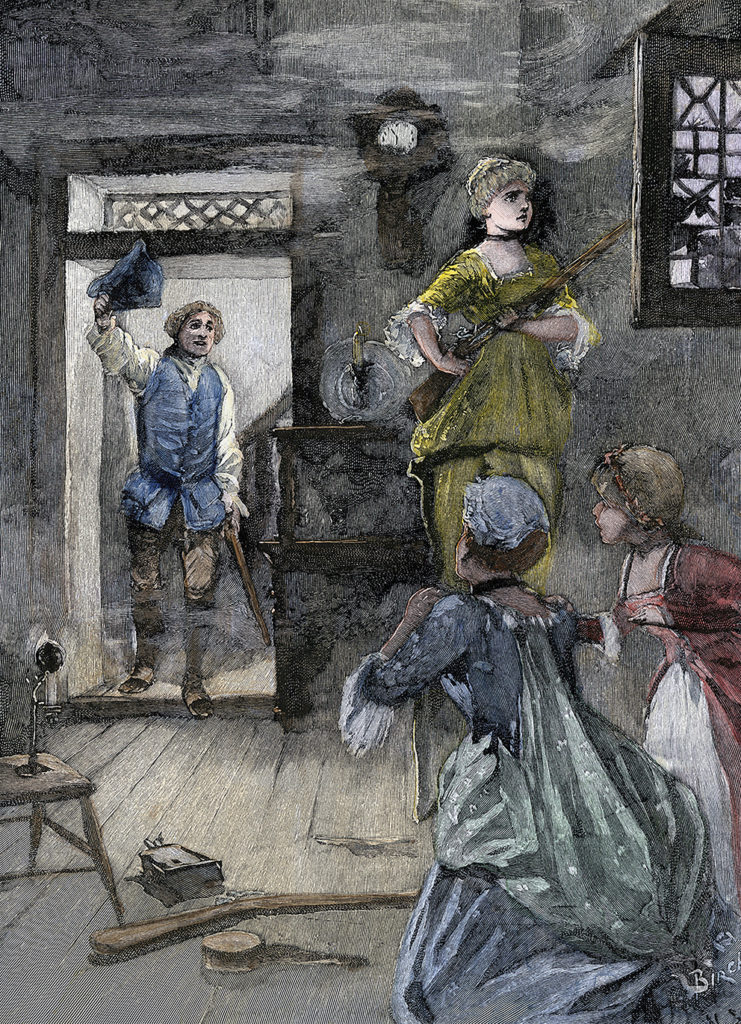
Young Mary Sanderson also lived on the main road, with her husband, her infant, and a four-year-old girl she was caring for.
The couple gathered the children and, “taking such articles as they could hurriedly collect and carry in their arms, by the light of a lantern,” made their way to her father’s remote home, whereupon Mary’s husband took his leave. At their house, on the main road, Deacon Joseph Loring’s daughters scurried to hide the communion silver in a brush heap out back, then made tracks. Once Abigail Harrington had sent her husband and son to the confrontation, she took her younger children “down a lane back of the house across a meadow to the old place on Smock farm.” For some, flight was particularly difficult: four women were still in childbed, having recently given birth, and three were within a few weeks of delivering.
At the Clarke parsonage, the parson and Dolly Quincy—John Hancock’s fiancée and at the time a guest of the Clarkes—hurriedly hid “money, watches, and anything [sic] down the potatoes and up Garrett.” Meanwhile, mother Lucy Clarke bundled her children into a wagon headed out of range. These women sought, as was their custom, the company of their sisters and female neighbors, gathering together for mutual support. Francis Brown’s widow recalled that the day of the fight her house, somewhat off the main road, was “full of women and children weeping. They hid their silver and mirrors and many other things in Russell’s swamp beyond Munroe’s brook.” Their terror was heightened by rumors that freedom-seeking bondsmen were to rise and murder defenseless noncombatants.
Some women experienced the fight at close quarters. Daniel Harrington’s wife, Anna, did not have time to flee her house, which was on the common, as her husband and father mustered. She was on hand as her father fell in battle, died, and was brought to her house, where his corpse was laid out.
Next door, Ruth Harrington, her young son with her, watched the battle, saw her husband fall, and, legend holds, watched helplessly as he crawled to his front stoop to die in her arms.
If the morning of April 19 had been full of fear and flight for Lexington’s women, the afternoon was full of horror and fury.
GET HISTORY’S GREATEST TALES—RIGHT IN YOUR INBOX
Subscribe to our HistoryNet Now! newsletter for the best of the past, delivered every Monday and Thursday.
In the early morning, with her three small children, Anna Munroe had stayed in her husband’s tavern on the main road. But that afternoon, as harried Redcoats were retreating under fire toward Boston, peril came her way. From her windows she could see Regulars rapidly advancing on her home. Gathering the family silver and her children, she fled out the tavern’s back door. Daughter Anna, nearly five years old, recounted the story of that flight to her grandchildren. Anna said she “…could remember seeing the men in red coats coming toward the house and how frightened her mother was when they ran from the house. . .one of the soldiers started to fire on her, but an officer knocked his arm up and said, ‘Do not fire on a woman.’” Later, Anna would recite, her mother used to take her on her lap and say, ‘This is my little girl that I was so afraid the Red coats would get.’”
As the Regulars were making their way east through Lexington, they took out their frustration on abandoned homesteads. The rampant destruction of their household goods was calamitous for women, a loss of all they had produced, acquired, and stewarded, and one that they catalogued and remembered. Lydia Mulliken, whose house and clock shop across from Munroe’s Tavern were burned to the ground, lost everything except silver serving pieces hidden in the wall behind her home.
Rebecca Mulliken, 13, particularly mourned the fate of “a pocket which with great pride she had embroidered with crewels,” and of whose loss she often spoke with regret in later years. The women of Deacon Loring’s family lost everything, including all that the daughters had accumulated to present as marriage portions through extra labor at tailoring and teaching. Mrs. Muzzy returned to her home to find that British soldiers had broken her mirror and valuable crockery, shot up a wall, and left the floor striped with blood. When Anna Munroe returned to her tavern, she found the soldiers had piled her furniture, including a mahogany table that had been part of her wedding furniture, and set a fire meant to burn the house down.
Next to the Munroe Tavern stood the humble little residence of Samuel and Mary Sanderson. When Samuel returned, he observed “. . .his house sacked, many articles destroyed, and their cow, a part of Mrs. Sanderson’s marriage portion or dower, killed, and a wounded British soldier quartered upon them.” When Mary Sanderson heard of the depredations, “she was greatly exasperated, declaring she would not return home from her father’s house to harbor and take care of the British soldier.” When she did return, her state of rage so terrified the wounded man that he feared to eat food she served him until someone had tasted it, in case she had poisoned his portion. “When over 100 years of age, Mrs. Sanderson described with minuteness many articles of her wardrobe and household goods that were destroyed or missing, rarely failing to mention the cow, and that it was a part of her marriage portion.” Her gravestone reads, “A witness of the first revolutionary conflict, she recounted its trying scenes to the last.”
The women, as well as the men, long remembered the 19th of April ’75, and all that had prefaced it, for they, too, had played their part with religious and civic zeal.
Lexington’s women had agreed that “something must be done,” and urged their men into battle. Theirs was, as historian Linda Kerber points out, a distinctively female patriotism. They had been mobilized by intertwined sacred and civic claims on their sex, and their commitment became part of the town’s energizing moral resources. These women sent their men to war as a “surrogate enlistment in a society in which women did not fight.” But they went further. They reimagined their traditional duties to join in that fight.

